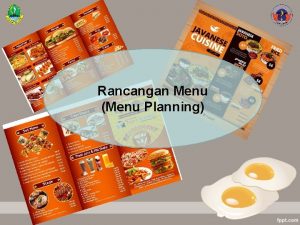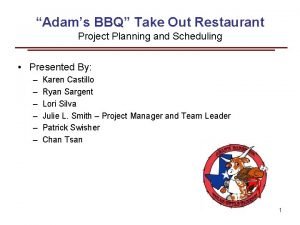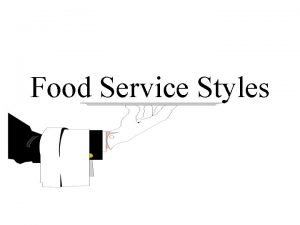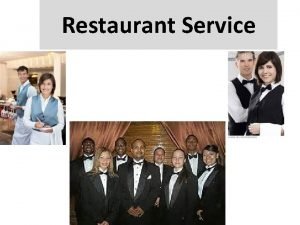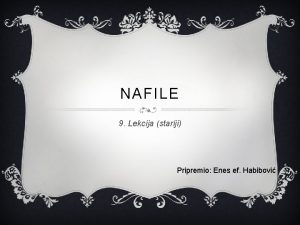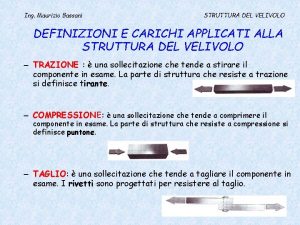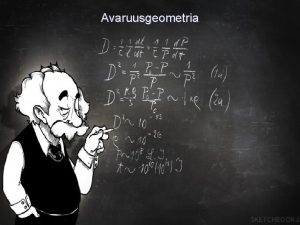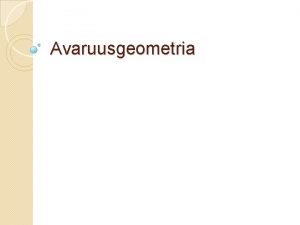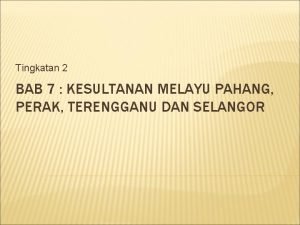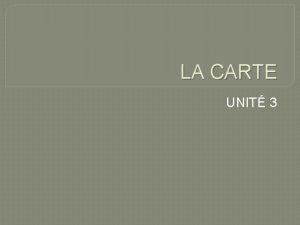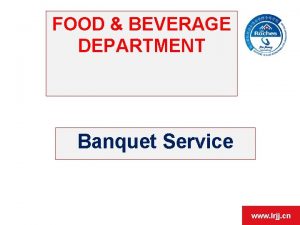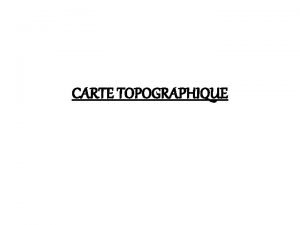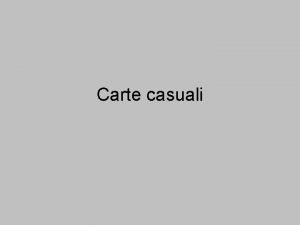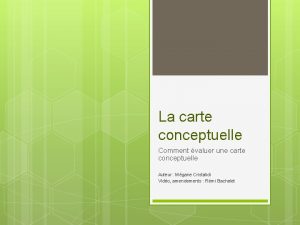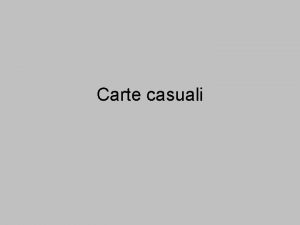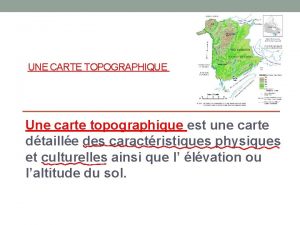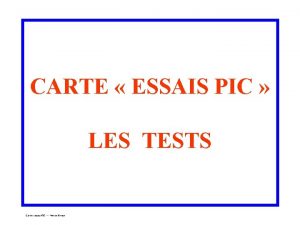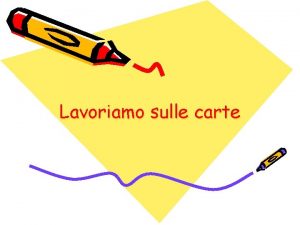Restaurant Ala Carte Sequence of Service www lrjj















































- Slides: 47

Restaurant Ala’ Carte Sequence of Service www. lrjj. cn

Contents Service Sequence 1. 2. 3. 4. 5. 6. 7. 8. 9. 10. 11. 12. Greet and seat the guests Open the napkins Offer iced water Serve the butter and the bread Take the F&B orders Describe and recommend dishes Transfer the check Correct & remove covers Serve beverage Announce the starter Serve the starter Clear the starter 13. Announce the main course 14. Serve the main course 15. Clear the main course 16. Announce the dessert 17. Serve the dessert 18. Take the coffee / tea order 19. Serve the coffee / tea 20. Prepare and present the bill 21. Accept payment 22. See the guests leaving 23. Clearing and re-setting 24. During the service period www. lrjj. cn

Service Sequence 1. Greet and seat the guests. § Welcome the guests as soon as they arrive. § Ask them if they have a reservation. Check the reservation. § If no table has been booked, check if one is available. § Show the guest their table. § Offer the guest a chair to encourage them to be seated. www. lrjj. cn

Service Sequence 2. Open the napkins § Some guests will open their own napkins as soon as they sit down. § Stand at the right of the guest, pick up the napkin with your right hand. § Shake the napkin from its fold into a triangle. § Place the longest side of the triangle closest to the guest. § Move anti-clockwise around the table opening the napkins, the host at last. www. lrjj. cn

Service Sequence 3. Offer iced water § Iced water is a valuable addition to the meal experience, and it is appreciated by the guest, although in some establishments it may not be the practice. § The water glass is positioned to the right of the wine glass above the table knife. § Water is poured from the guest right side, with your right hand. § Move anti-clockwise around the table, the host at last. Offer water throughout the meal. www. lrjj. cn

Service Sequence 4. Serve the butter and the bread § Place the butter plate in the center of the table, with the right hand. § Hold the bread basket on your left hand serve from the guest left side. § Hold the bread basket down over the edge of the side plate. § Transfer the bread from the basket to the side plate using service fork and spoon. § Move anti-clockwise around the table, the host at last. Offer bread throughout the meal www. lrjj. cn

Service Sequence 5. Describe and recommend dishes § Allow time for the guest to make their choice. § When all the guests are seated, be alert to the signs that the guests are ready to order so they are not kept waiting. § You must be able to describe dishes, how they are cooked, accurately, and attractively. § You may also be asked to recommend dishes. To say “Everything is good” is not helpful. www. lrjj. cn

Service Sequence 6. Take the F&B orders § When you are sure the guests are ready to order, a) introduce yourself and b) ask what they would like to eat and drink ? § Start to take the order of the guest on the right of the host, and work anti-clockwise around the table, finishing with the host’s order. § Take the order including the starter, the main course, the dessert, and beverages. § Note any special requirements § Repeat the order to the guests to make sure that the order is correct. www. lrjj. cn

Service Sequence 7. Transfer the check § The check must be clearly written in the same language as the menu. § If you use abbreviations, be sure to use agreed abbreviations only. § The check must contain at least: a) Table number b) Number of covers c) Date d) Waiter’s signature § Transfer the top copy to the kitchen, the second copy to the bar, the third copy to the cashier, and the fourth copy for you. www. lrjj. cn

Service Sequence 8. Correct & remove covers § To correct a cover is to adjust the cutlery originally laid to meet a guest’s specific order. § Starting with the guest on the right of the host, move anti-clockwise, finishing with the host § To adjust the cutlery, lift the item not required and replace it with the correct one. § Remove unnecessary cutlery and glassware from the table. www. lrjj. cn

Service Sequence 9. Serve beverage § Take the beverages at the bar. Be sure to know who drinks what. It is not professional to ask the guest. § All glassware, whether clean or used, should be carried upright on a drink tray, held only by the base of the glass. Hold the tray with your left hand, and use your right hand to place the drink from the guest’s right side. § Beverage Service sequence (see 11) § Throughout the meal, if the guest’s glass look nearly empty, ask if he/she wants another drink. www. lrjj. cn

Service Sequence 10. Announce the starter § When ready to serve the starter, go to the kitchen and announce the starter § Say something like: “Please, starter for table 4”. § When you receive the food from the kitchen, be sure to know who eats what. It is not professional to ask the guest. www. lrjj. cn

Service Sequence 11. Serve the starter § In modern plate service, plates are both placed and cleared from the guest’s right side, as this causes the least disturbance to the guest. § In modern plate service, serve the guest immediately to the right of the host first, and then move anti-clockwise around the table, serving each guest in turn, regardless of sex. The host to be served at last. § In some establishments, you may be required to serve ladies before gentlemen, or this may be required by the guests. www. lrjj. cn

Service Sequence 12. Clear the starter § Guest usually indicate that they have finished their course by placing the cutlery together on the plate. § As they don’t always do this, you must be alert to other signs from the table that everyone has finished, and if necessary, you must ask guests whether they are finished or not. § In modern plate service, it is usual to clear at once, when all guest have finished, from the right side of the guest, by using your right hand. www. lrjj. cn

Service Sequence 13. Announce the main course § When ready to serve the main course, go to the kitchen and announce the main course. § Say something like: “Please, main course for table 4”. § When you receive the food from the kitchen, be sure to know who eats what. It is not professional to ask the guest. www. lrjj. cn

Service Sequence 14. Serve the main course § As for the starter, plates are both placed and cleared from the guest’s right side, as this causes the least disturbance to the guest. § Serve the guest immediately to the right of the host first, and then move anticlockwise around the table, serving each guest in turn, regard-less of sex. The host to be served at last. § In some establishments, you may be required to serve ladies before gentlemen, or this may be required by the guests. www. lrjj. cn

Service Sequence 15. Clear the main course § Guest usually indicate that they have finished their main course by placing the cutlery together on the plate. § If necessary, you must ask guests whether they are finished or not. § Clear at once, when all guest have finished, from the right side of the guest, by using your right hand. § Brush the crumbs onto the a dinner plate using a folded service cloth held in your right hand adjust the dessert cutlery. www. lrjj. cn

Service Sequence 16. Announce the dessert § When ready to serve the dessert, go to the kitchen and announce the dessert. § Say something like: “Please, dessert for table 4”. § When you receive the food from the kitchen, be sure to know who eats what. It is not professional to ask the guest. www. lrjj. cn

Service Sequence 17. Serve the dessert § Plates are both placed and cleared from the guest’s right side, as this causes the least disturbance to the guest. § Serve the guest immediately to the right of the host first, and then move anticlockwise around the table, serving each guest in turn, regard-less of sex. The host to be served at last. § In some establishments, you may be required to serve ladies before gentlemen, or this may be required by the guests. www. lrjj. cn

Service Sequence 18. Take the coffee / tea order § The coffee / tea may be served with the dessert if requested by the guest, therefore, you may be asked the take the order before serving the dessert. § Start to take the order of the guest on the right of the host, and work anti-clockwise around the table, finishing with the host’s order. § Transfer the top copy to the bar, the third copy to the cashier, and the fourth copy for you. www. lrjj. cn

Service Sequence 19. Serve the coffee / tea § Place the accompanying items (milk, sugar) on the table. § Serve the guest immediately to the right of the host first, and then move anti-clockwise around the table, serving each guest in turn, regardless of sex. The host to be served at last. § In some establishments, you may be required to serve ladies before gentlemen, or this may be required by the guests. www. lrjj. cn

Service Sequence 20. Prepare and present the bill § At this point. it is essential that you should be ready to give the bill. Prepare it or make sure it is ready. § Nothing is more irritating to guests than to be slowness in the bringing of the bill. § Generally, bills should not be presented until they are asked for. § When a bill is presented at the table, it is placed in front of the host, or, if there is no host, in the middle of the table. www. lrjj. cn

Service Sequence 21. Accept payment § If the establishment requires guests to pay at a cashier’s desk as they are leaving, make this clear to the guest. § Do not hover around waiting for your guests to pay, leave them alone. § Accept payment and tender exchange. www. lrjj. cn

Service Sequence 22. See the guests leaving § Assist the guest departing by moving their chairs for them, collecting their personal belonging (not forgetting coats, hats and bags). § If you are too busy, at least acknowledge their departure with a nod and a smile § Wish your guest “Good afternoon” and thank them for coming. If your know their name, use it: “Good afternoon Mr. Benice. We look forward to seeing you again soon”. www. lrjj. cn

Service Sequence 23. Clearing and re-setting § Remove dessert plates and coffee cups by hand. Glassware should be removed on a drinks tray. § Only when all the guests have left the restaurant, remove the flowers on a tray and put them in the refrigerator. § Then, remove the dirty napkins and tablecloths. § Ensure that all the tables and chairs are returned to their original positions. Do not forget to check chairs for crumbs. www. lrjj. cn

Service Sequence 24. During the service period § Offer bread throughout the meal. § Offer water throughout the meal. § When you can, help your colleagues. § If you forgot to do something or if you did a mistake, correct it. § Don’t forget the most important thing: smile and be kind. www. lrjj. cn

• Taking Reservations www. lrjj. cn

Taking Reservations Before you take booking, make sure you know the answers to the following type of questions: § What kind of food do you offer? § Do you accept credit cards? § When are you open? § Are children welcome? § Are you air conditioned? § Is there a no-smoking area? § Do you have car parking facilities? § Do you cater for functions? § How do I find your establishment? www. lrjj. cn

Taking Reservations Most reservation are taken over the telephone. A friendly and helpful telephone manner is essential. § Always answer the telephone promptly when it rings § Have a pen and paper or the reservations book to hand § State clearly the name of the establishment § Offer the caller your assistance: “Good morning, may I help you? ” § Answer any questions clearly and politely. If you do not know the answer, find someone who does or offer to call back. § Before beginning to take the booking, make sure you have the reservation books in view. www. lrjj. cn

Taking Reservations The first things to be clarified are when the table is required and how many people they are in the party. Only when you have established that a suitable is available, then ask for the following details: § The host’s name (have it spelt out if you are not sure) § The time of arrival § A contact telephone number (mobile) § Any special requirements § Confirm all the details by repeating the name, the day and date, the time of arrival, the number in the party, contact phone number and tell the reservation policy. § Complete the conversation by thanking the guest. www. lrjj. cn

Station Mise-en-Place A waiter’s station should carry the following: § All the necessary cutlery, for example knives soup spoon, main knives and forks, dessert spoons and forks, etc… § Service utensils (tablespoons and forks) § Crumbing down equipment § Service plates § Tea/coffee service equipment (milk jugs, sugar bowls…) § Bread service equipment § Napkins § Service tray § Toothpicks www. lrjj. cn

Station Mise-en-Place § Menus § Wine list § Spare Guest Check and pen § Condiments (sauces, pepper-mill, salt) § Clean table linen § Candles § Additional items. www. lrjj. cn

How to lay a cover There are two principal types of covers a) à la carte and b) set menu (table d’hôte) cover. Whatever the type of cover to be laid, the following rules apply: § All cutlery and glassware should be cleaned and polished before they are placed on the table. § The main knife and fork should be positioned 1 cm from the edge of the table. § Side plate are always positioned to the guest’s left. § The blades of all knives on the cover should face left. § Side knives are placed on the side plate to its right hand side. § The water glass is positioned 2 cm from the top of the main knife. Additional red wine and white wine glasses are positioned at a 45 o angle to the right, or in triangle. § A folded napkin is placed in the centre of the cover. www. lrjj. cn

Menu (from restaurant atmosphere) The menu cover and contents should reflect the design and style of the restaurant. The design of the menu, its details, the style of type used, and the impression it creates all set the atmosphere. A small, simple menu in a color that harmonizes with the decor is desirable. It should set the feeling of the restaurant. Customers are not impressed by dirty, dogeared menus stuck together with adhesive tape. Menus should be simple and easy to read and understand. They should carefully describe the food served. A short but descriptive statement about major items served can stimulate the appetite and measurably increase the guest check. www. lrjj. cn

Importance of the Menu First, the menu is a contract with the customer, an indication that what is described on the menu is what will be delivered to the customer. Respect truth in Menu: (freshness, geographical origin, picture, quantity…) Second, the menu is a form of a product brochure. The menu should identify the name of each dish, major ingredients and how the dish is prepared in a appealing way, and without too many unfamiliar items. (the use of complicated names are risky) Third, it is an essential part of the marketing effort. It is the first tangible connection your guests have between their interest in buying (why they are there) and what you have to sell. The menu is a selling tool: properly priced designed, and presented, the menu can increase the average check, the frequency of visits, the party size, or attract new guests. www. lrjj. cn

Listing Prices À la Carte Menu: Food & Beverage items are listed and priced separately. The guest choose from various appetizers, main courses, desserts. For the guest, the initial perception is that prices look low. This approach appeals to customers who like to individualize their meal. It does complicate the pricing of checks for the employees. Table d’Hôte Menu: List of a complete meal (3 to 8 course) for one price. This menu can be called “fixed price” or “meal package”. The guest eats a complete menu that has been planed in advance for them. Combination Menu: some restaurants offers both, Table d’Hôte & À la Carte Menus. (Chinese Restaurants, Fast Food). The guest can compare prices between the meal packages with the à la Carte Menu. www. lrjj. cn

Menu Sequence According to western countries and based on the French food culture, a meal include the following courses (maximum 8): 1) cold appetizer 2) soup 3) hot appetizers to 4) Fish 5) Sherbet (which is a water ice) 6) Main Course or Entrée 7) Cheese and 8) Dessert. An “À la Carte” or “Table d’Hôte” menu can follow this meal progression. www. lrjj. cn

PRICING & DESIGNING THE MENU PR. International Cuisine Restaurant Menu February 24 th – February 28 th Eggs Mayonnaise Two egg halves on a bed of lettuce topped with mayonnaise or French Onion Soup A French tradition served ''au gratin'' or Potage Crecy A light cream soup with puree of carrots and a hint of orange or Chef's Salad Julienne of Chicken, cheese and vegetables on a bed of lettuce served with a blue cheese dressing ***** www. lrjj. cn

PRICING & DESIGNING THE MENU ***** Spinch Lasagna Fresh spinch pasta sheets layered with beef and cheese or Lamb Cutlets ''Reforme'' Lightly breaded lamb cutlets served with julienne vegetables and accompanied by a red pepper sauce or Rainbow trout ''Grenobloise'' A whole de-boned trout stuffed and delicately fried in butter ***** Cheese Mousse or Maltaise Rice Pudding 7, 500, 000 TL www. lrjj. cn

PRICING & DESIGNING THE MENU ***** Spinch Lasagna Fresh spinch pasta sheets layered with beef and cheese or Lamb Cutlets ''Reforme'' Lightly breaded lamb cutlets served with julienne vegetables and accompanied by a red pepper sauce or Rainbow trout ''Grenobloise'' A whole de-boned trout stuffed and delicately fried in butter ***** Cheese Mousse or Maltaise Rice Pudding 7, 500, 000 TL www. lrjj. cn

Plate service skills and techniques In professional plate service no more than four plates are carried at a time. The two professional methods are the two- and three-plate carrying techniques. These involve carrying two or three plates in the left hand, having the right hand free. The right hand can be used to carry another plate. www. lrjj. cn

Plate service procedure § In modern plate service, plates are both placed and cleared from the guest’s right side, as this causes the least disturbance to the guest. § In modern plate service, serve the guest immediately to the right of the host first, and then move anticlockwise around the table, serving each guest in turn, regard-less of sex. The host to be served at last. § In some establishments, you may be required to serve ladies before gentlemen, or this may be required by the guests. www. lrjj. cn

Two-plate carrying technique § Hold the first plate between your thumb, index finger and the middle finger of your left hand. If the plate is hot, use a service cloth. § Then place the second plate on a platform above the first plate, supporting it by your ring finger, your little finger, and the base of your thumb and lower forearm. § Carry the plates to the table holding them away from your body. To place the plates in front of your guests, position yourself at the back right hand corner of the guest chair. § The plate should be placed so that the main item (meat, fish, etc…) is immediately in www. lrjj. cn front of the guest.

Silver Service Silver service is the technique of transferring food from a service dish to the guest’s plate from the left with the use of service cutlery. This usually means a service spoon and fork, but occasionally it consists of knives. Silver service requires the waiter to be able to use the cutlery to serve the food with one hand. www. lrjj. cn

Use of spoon and fork Silver service takes place from the left of the guest, holding the Place a fork over a spoon in your right hand, both facing up. Slide your index finger between the fork and the spoon Lift food items with the spoon and hold them firmly in place with the fork while transferring them to the guest’s plate. www. lrjj. cn

Silver service procedure Place clean hot plates in front of the guests from the right. Hold the service dish on the flat of your left hand, over the guest’s plate, no more than 5 cm above it. Place the main item of the course to the front of the guest’s plate. Place the vegetables and garniture behind the main item. Note that no items are placed on the rim of the plate. Place presentation should be consistent. Move anti-clockwise round the table serving each guest in turn, with the host at last. www. lrjj. cn

Silver service of sauces In silver service, accompanying sauces should not be carried on the same serving dish as the food. They are offered separately using a sauce boat on a underplate. Sauces are never poured direct from the sauce boat. A spoon is always used to serve them. www. lrjj. cn
 Service sequence in serving food and beverage
Service sequence in serving food and beverage Wa tu izzu man tasha in english
Wa tu izzu man tasha in english Attahiyat dua in english
Attahiyat dua in english Contoh menu planning
Contoh menu planning Contoh standar resep
Contoh standar resep Breakfast table setting
Breakfast table setting Work breakdown structure for restaurant
Work breakdown structure for restaurant Uml sequence diagram return value
Uml sequence diagram return value Sequence diagram of restaurant management system
Sequence diagram of restaurant management system Food service styles
Food service styles Single point service
Single point service Nucleotides of rna
Nucleotides of rna Repetition in pseudocode
Repetition in pseudocode What is the difference between finite and infinite sequence
What is the difference between finite and infinite sequence Convolutional sequence to sequence learning.
Convolutional sequence to sequence learning. Food and beverage service sequence
Food and beverage service sequence Service sequence in serving food and beverage
Service sequence in serving food and beverage Food and beverage service standards manual
Food and beverage service standards manual Ala market from apex telecom
Ala market from apex telecom Ala esquerda futsal
Ala esquerda futsal De guadalajara vengo trabalenguas
De guadalajara vengo trabalenguas Muro ala
Muro ala Ve inneke ala hulukin azim
Ve inneke ala hulukin azim Ferroşelataz
Ferroşelataz Hem sentezi nedir
Hem sentezi nedir Dr ala mohsen
Dr ala mohsen Muagagana ma alagaupu fa'asamoa
Muagagana ma alagaupu fa'asamoa Norja pinta-ala
Norja pinta-ala Kako klanjati 2 rekata nafile
Kako klanjati 2 rekata nafile Chrims
Chrims Neliön piiri
Neliön piiri Poema ala madre tierra
Poema ala madre tierra 2
2 Ala controventata
Ala controventata Pertrochanterica
Pertrochanterica Diaporamaalacon
Diaporamaalacon Romanos 8 38
Romanos 8 38 Avaruusgeometria
Avaruusgeometria Allahumma rabba muhammadin
Allahumma rabba muhammadin Ala yuken
Ala yuken Processus pterygoideus lamina lateralis
Processus pterygoideus lamina lateralis Para cuando dios hizo a la mujer ya estaba en su sexto
Para cuando dios hizo a la mujer ya estaba en su sexto Novena de la divina misericordia
Novena de la divina misericordia Maa ala millelt vesi koguneb ühte jõkke
Maa ala millelt vesi koguneb ühte jõkke Allah el misericordioso
Allah el misericordioso Un'ala di riserva don tonino bello
Un'ala di riserva don tonino bello Kolmisivuinen pyramidi
Kolmisivuinen pyramidi Sejarah kesultanan perak tingkatan 2
Sejarah kesultanan perak tingkatan 2



